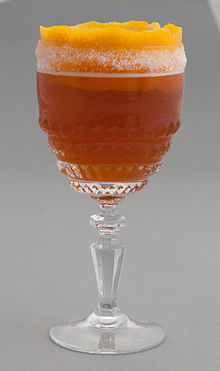Crusta (cocktail)
Crusta is a name for a small group of classic cocktails . In their composition, crustas are similar to a sour , i.e. contain a spirit , lemon juice as well as sugar or sugar syrup and / or liqueur and are also often rounded off with cocktail bitters . A special feature is (a broad sugar rim on the glass, the eponymous crust English. Crust ), and a long, wide-cut spiral of lemon or orange peel, which is placed in the glass. Crustas are mixed with ice, but usually served straight up, i.e. without ice, in a bulbous glass, for example a small wine glass or a cognac snifter. The most famous crusta is the brandy crusta with cognac or brandy .
history
Crustas are among the "oldies" at the bar and were known as an independent beverage group as early as the 19th century, at a time when the term "cocktail" only included a small group of alcoholic mixed drinks and had not yet established itself as a generic term . Jerry Thomas , who in 1862 published one of the first specialist books specifically for alcoholic mixed drinks in the United States , dedicated the chapter "The Cocktail & Crusta" to both groups. In it, he described the “crusta” as an improvement on the mixed drink “cocktail”, which has been known since the beginning of the 19th century, and traced it back to a Spanish caterer named Santina. Joseph Santina worked at the Jewel of the South in New Orleans in the 1840s and 1850s . In the recipe for a Brandy Crusta, Thomas referred to the Brandy Cocktail . This was prepared from brandy and a few spritzes of sugar syrup, cocktail bitters and curacao liqueur, the variant Fancy Brandy Cocktail differed with otherwise the same ingredients in that it was served in a "fancy", that is, fashionable, decorated wine glass Edge was moistened with a little lemon juice. A lemon zest was added to the drink as a decoration .
“115. Brandy Crusta. (Use small bar glass.) Crusta is made the same as a fancy cocktail, with a little lemon juice and a small lump of ice added. First, mix the ingredients in a small tumbler, then take a fancy red wine-glass, rub a sliced lemon around the rim of the same, and dip it in pulverized white sugar, so that the sugar will adhere to the edge of the glass . Pare half a lemon the same as you would an apple (all in one piece) so that the paring will fit in the wine-glass, as shown in the cut, and strain the crusta from the tumbler into it. Then smile. "
"115. Brandy Crusta. (Take a small bar glass.) A crusta is prepared like a fancy cocktail, with a little lemon juice and a piece of ice. First the ingredients are mixed in a small beaker, then you take a fashionably decorated red wine glass, rub a lemon wedge around its rim and dip it in powdered sugar so that it sticks to the edge of the glass. A lemon is peeled in one piece like an apple so that the peel fits into the wine glass as shown. Finally, the crusta is strained from the beaker into the glass. Then smile. "
Thomas mentioned the whiskey crusta and the gin crusta as variants , for which whiskey and gin are used instead of brandy with otherwise the same preparation . It should be noted here that in 1862 gin actually meant Genever, which was also known as "Hollands" at the time . In terms of taste, it was more reminiscent of whiskey than the Plymouth and London Dry gins commonly used today , which only became established in the United States in the course of the 1880s.
preparation
The classic crusta preparation described by Jerry Thomas has hardly changed since the mid-19th century. The brandy crusta in particular has been featured in most classically oriented recipe collections since then. In the Cocktailian bar book (2010) it consists of 6 cl brandy, 1 bottle each of orange curacao and sugar syrup , 1 cl lemon juice and 2 dashes (splashes) of Angostura bitter , is shaken with ice cubes in the cocktail shaker and double-strained into the guest glass , which was previously filled with a spiral from the peel of half a lemon and bordered with sugar. Different liqueurs are sometimes used, for example the maraschino, which was also popular in the 19th century .
Individual evidence
- ↑ a b Simon Difford: Cocktails # 10 . Odd Firm of Sin (self-published), London 2012, ISBN 978-0955627620 , entry on Brandy Crusta, p. 136 (English).
- ↑ a b Uwe Voigt: The great textbook of the bar customer. A handy guide for professional bartenders, bar masters, and bar managers. 2nd, revised edition, Matthaes Verlag, Stuttgart 2007, ISBN 978-3-87515-018-6 , p. 127.
- ↑ a b c Jerry Thomas: How to Mix Drinks, or the Bon-Vivant's Companion. Dick & Fitzgerald, New York 1862, pp. 49f. Complete texts at Google Books (also as PDF): Schlesinger Library ; Harvard College Library ; Facsimile reprint: Ross Brown (SoHo Books), 2009, ISBN 978-1440453267 . An expanded edition appeared in 1876.
- ↑ Jerry Thomas: How to Mix Drinks, or the Bon-Vivant's Companion. Dick & Fitzgerald, New York 1862, p. 52. Translation: User: Mangomix .
- ^ Gary "Gaz" Regan: the bartender's GIN compendium. Self-published (Xlibris), USA 2009, ISBN 978-1-4415-4688-3 , pp. 30f.
- ↑ Helmut Adam , Jens Hasenbein, Bastian Heuser: Cocktailian. The bar's manual . Tre Torri, Wiesbaden 2010, ISBN 978-3-941641-41-9 , p. 383.
